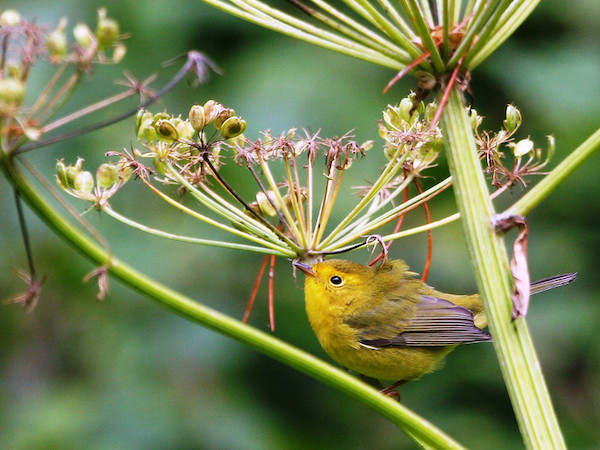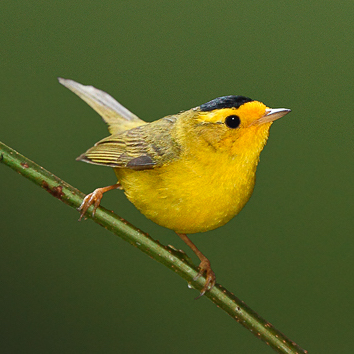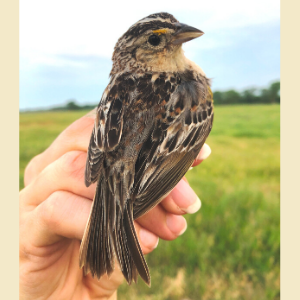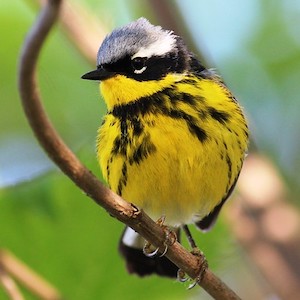Conserving migratory species is tricky in part because most are hard to count, and they don't stay put. They don't give a hoot about political boundaries (national, state and municipal borders mean nothing to them) and they never tell you where they are going. Counting birds is hard enough–ask anyone who has ever participated in a Christmas Bird Count. (Are there 50 House Sparrows in that flock or 60? I know there must be at least 5 Song Sparrows in that thicket, but only one is chipping at me so I can't count the rest.) Tracking birds is even harder. Though new technology like geolocators or miniaturized GPS devices have helped enormously, the number of these devices that would need to be deployed (and in some cases retrieved as well) to thoroughly map birds' migratory movements is staggering.

Range map for Wilson's Warbler. Image from Cornell Lab of Ornithology www.allaboutbirds.org
Now scientists are using advances in genetic sequencing and statistical modeling to better understand not only how many birds of a given species there are, but how that species is subdivided into populations and which populations migrate where. In a recent paper in the journal Conservation Biology, Colorado State University Assistant Professor and IBP Research Associate Dr. Kristen Ruegg and IBP Research Ecologist Dr. Jim Saracco, along with colleagues from the University of California and Tulane University developed a "genoscape-network" model to help decision makers prioritize conservation actions to protect Wilson's Warblers, a neotropical migrant.
Wilson's Warblers as a species are declining, but not to the same degree in all regions of their breeding range. The greater global population of Wilson's Warbler is made up of distinct populations that breed in different regions in Canada and the US, and that winter in different regions of Mexico and Central America. Ruegg and her colleagues used genome-wide sequencing to distinguish warblers from different populations and determine where they spent the non-breeding season. DNA samples used in the genetic sequencing came from feathers collected by bird banders, many of whom are partners in IBP's MAPS (Monitoring Avian Productivity and Survivorship) program in the US and Canada, and MoSI (Monitoreo De Sobrevivencia Invernal) program in Mexico and Central America.
Genes can tell you about populations within a species because birds that breed in the same region are more likely to breed with each other and so will be more closely related and share more genes, than with birds that breed in a distant region. They can also tell you about where different populations winter. For instance, if a large portion of birds that you catch in southern Baja are most genetically similar to the birds that breed in the Pacific Northwest, that indicates that Baja is one of the regions that the Pacific Northwest population winters.

Pie charts indicate what proportion of each breeding population was captured at each location: upper pies are breeding locations (which define the populations), lower pies are wintering locations.
Earlier genetic analysis by Ruegg and colleagues had shown that Wilson's Warblers can be roughly divided into 6 breeding populations: Eastern Boreal, Western Boreal, Pacific Northwest, Basin Rockies, California Sierras, and California Coastal. These populations spend the winter in 5 regions: southern Baja, western Mexico, central Mexico, the Yucatan and Central America. Some populations only winter in one of these regions, while others are distributed across 3 regions. To estimate the size of these different populations the researchers turned to Breeding Bird Survey (BBS) data and eBird data. The highest breeding densities were in the Pacific Northwest and Western Boreal populations and the lowest was in the Basin Rockies. The largest wintering densities were in Central America.
That's a lot of different types of data about Wilson's Warblers: counts, locations, genetics, and more. To make the best conservation decisions for the species, you would ideally consider all this information as a whole. But how? That's where the advanced statistical modeling comes in. The researchers used a "spatial migratory network" model, which is a type of graphical model composed of "nodes" that represent non-breeding and breeding regions, and "links" that represent the degree of known migration between nodes. Then they combined this model with a "genoscape," which is a map of genetic variation across a species range.
"Visualizing the entire global population of Wilson's Warblers as a network makes it clear how breeding regions and overwintering regions are connected," says Dr. Caz Taylor, a professor at Tulane University and senior author of the paper. "We can look at a network and see immediately that a Wilson's Warbler wintering in Central America is most likely to be a member of the Western Boreal group, or we can see where the birds that breed in coastal California spend the winter."
This in turn allowed the researchers to evaluate which conservation efforts would be appropriate given different conservation priorities. For instance, if conserving the largest number of individual Wilson's Warblers was the priority, conservation efforts should target the Pacific Northwest, which has the highest breeding density as well as Central America which has the highest wintering density. But if the priority was to conserve genetic diversity in Wilson's Warblers, it would be best to expend effort in the Basin Rockies, Coastal California, or California Sierra Nevada because those 3 populations (or genetic groups) are the most vulnerable. Likewise targeting western Mexico and southern Baja would be a good strategy because 2 of these populations spend the winter in those regions.
Why might preserving genetic diversity be a priority? Ruegg, one of the paper's lead authors responds: "When you preserve genetically distinct groups, you preserve a lineage's ability to respond to stress either from habitat disturbance or disease." This is because different genetic groups have different "co-adapted gene complexes," kind of like teams of genes that work well together, that have allowed them to adapt to the different environments they live in. The process of natural selection acts on variation and evolution can't take place without it. "Preserving genetic diversity within a lineage helps preserve its ability to evolve disease resistance and/or adapt in the face of changing climate conditions," says Ruegg. "Our model showed that 85% of Wilson's Warblers belong to one population or genetic group: Western Boreal - so preserving genetic diversity by focusing efforts on the other five less common genetic groups might be a priority for this species."
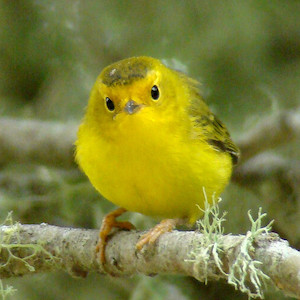
Wilson's Warbler. Photo by Maggie Smith/Flickr
While the researchers used the Wilson's Warbler as a test case for this genoscape-network model, it could also be applied to other migratory birds. "We are faced with lots of migratory bird species that are declining and we now have the tools to better understand how these species may stratify into distinct populations and how they are connected throughout the life cycle," says Saracco "this is a key first step for understanding the population dynamics of these species and how to conserve them." Ruegg already has a next candidate in mind: "I think this will be really useful for species like the Willow Flycatcher where you have some genetically distinct populations, like the Southwest Willow Flycatcher, that are near extinction," she says.
This genoscape-network model creates a framework that integrates population trends, genetic groups, and the migratory cycle. This is likely the first published migratory network model that integrates genetic information below the species level (the population level). But it's not just a novelty, it is a tool that will enable conservationists to better prioritize their efforts and limited funding. In a rapidly changing world where so many bird species are declining, making well-informed conservation choices is more important than ever.


